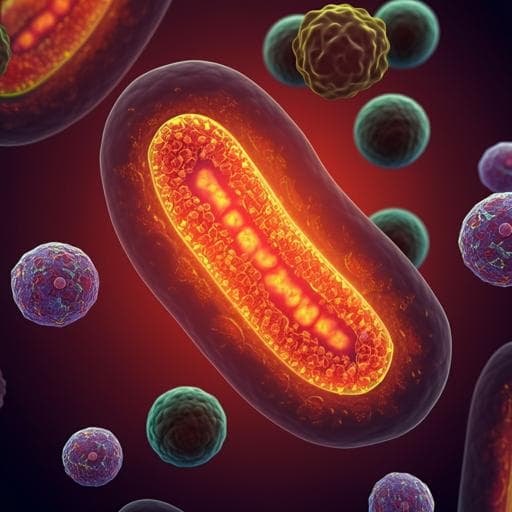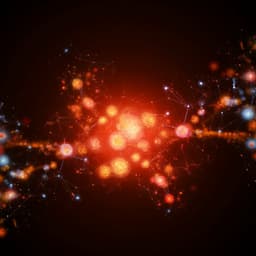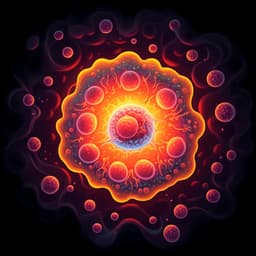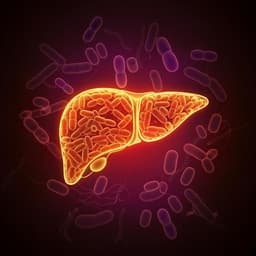
Medicine and Health
N-acetylcysteine supplementation did not reverse mitochondrial oxidative stress, apoptosis, and inflammation in the salivary glands of hyperglycemic rats
Z. Anna, K. Joanna, et al.
This study by Zalewska Anna and colleagues explores whether N-acetylcysteine supplementation can counteract harmful effects of a high-fat diet on salivary gland function in hyperglycemic rats. Discover how NAC influences mitochondrial activity and inflammatory markers, and what implications this may have for oxidative stress management.
~3 min • Beginner • English
Introduction
Chronic exposure to a high-fat diet (HFD) disrupts carbohydrate metabolism and contributes to mitochondrial dysregulation. Prior work showed HFD impairs mitochondrial function, decreases ATP generation, and increases reactive oxygen species (ROS) formation in salivary glands. Hyperglycemia augments mitochondrial oxygen consumption, shifts electron transport toward complex II, elevates ROS production, increases ADP regeneration, reduces ATP, and depolarizes mitochondrial membranes. Hyperglycemia-related mitochondrial dysfunction promotes insulin resistance and type 2 diabetes complications. Interventions that restore glycemia, improve insulin sensitivity, and support mitochondrial function at the hyperglycemic stage are therefore sought. N-acetylcysteine (NAC), a glutathione (GSH) analog, can enhance mitochondrial oxidative phosphorylation and activities of respiratory complexes in various tissues. Previous research from the authors showed that simultaneous HFD feeding and NAC supplementation prevented hyperglycemia, strengthened cytoplasmic antioxidant defenses, and protected against oxidative damage in salivary glands, normalizing activities of complexes I, II+III, and cytochrome c oxidase (COX) and the ADP/ATP ratio. However, it remained unknown whether NAC introduced after hyperglycemia is established could reverse HFD-induced mitochondrial dysfunction in salivary glands. The present study evaluates whether NAC supplementation at the hyperglycemic stage can reverse mitochondrial respiratory chain dysfunction, and reduce apoptosis and mitochondrial pro-oxidative enzyme activity in salivary glands, and whether NAC-related changes in salivary secretion relate to mitochondrial function.
Literature Review
Methodology
Ethics and design: Approved by the Local Ethical Committee for Animal Experiments in Olsztyn (No. 21/2017). Male Wistar rats (n=40; 4–5 weeks; 69–72 g) were housed two per cage under 12 h light/dark, 20–21 °C, with water ad libitum. After 5-day acclimation, rats were randomized (n=20/group) to: standard diet (10% fat, 20% protein, 70% carbohydrate; Research Diet D12450J) or high-fat diet (HFD; 60% fat, 20% protein, 20% carbohydrate; D12492) for 6 weeks. Blinding was not used. Inclusion/exclusion: After 6 weeks, tail-vein glucose was measured; rats with glucose <70 or >150 mg/dL or poor condition were excluded. All HFD rats had glucose 95–135 mg/dL; controls <86 mg/dL; all in good condition. Groups were then split into four subgroups (n=10 each) for a further 4 weeks: C (standard diet), C+NAC (standard diet + NAC 500 mg/kg BW intragastrically once daily 8–9 AM), HFD (continued HFD), HFD+NAC (continued HFD + NAC 500 mg/kg BW i.g. once daily). Saline (2 mL/kg BW i.g.) was administered to non-NAC groups to match handling. NAC dose was adjusted bi-daily based on body weight; dose selection based on literature for safety and antioxidant efficacy. Outcomes and sampling: At week 10 (after overnight fast), rats were anesthetized with phenobarbital (80 mg/kg BW). Tail-vein glucose measured; exclusion thresholds <70 or >150 mg/dL. Non-stimulated (NWS) and stimulated whole saliva (SWS) secretion were measured. Blood from abdominal aorta collected into EDTA; plasma stored at −80 °C with protease inhibitors and BHT. Plasma insulin (ELISA) and free fatty acids (gas chromatography) were assessed; insulin resistance calculated by HOMA-IR = fasting insulin [U/mL] × fasting glucose [mM]/22.5. Parotid (PG) and submandibular (SMG) glands were excised, weighed, and salivary gland index calculated (gland weight/BW). Mitochondrial isolation: Tissues homogenized (1:10 w/v) in ice-cold isolation buffer (250 mM sucrose, 5 mM Tris-HCl, 2 mM EGTA, protease inhibitors, BHT), centrifuged (500×g 10 min, 4 °C; then 8000×g twice). Purity verified by Western blot (absence of cytosolic GAPDH and nuclear histone H3). Biochemical assays in mitochondrial fraction (standardized per mg mitochondrial protein): - Respiratory chain: Complex I (NADH:ubiquinone oxidoreductase) by DCIP reduction; Complex II and Complex II+III (succinate dehydrogenase and succinate:cytochrome c reductase) per Rustin et al. - Energy/redox: ADP/ATP ratio (luciferase-based bioluminescence; Abcam ab65313); hydrogen peroxide (Amplex Red). - Enzymes: COX (complex IV; oxidation of reduced cytochrome c); citrate synthase (CS; DTNB-based). - ROS sources: NADPH oxidase (NOX; luminescence); xanthine oxidase (XO; uric acid formation at 290 nm). - ROS production: DCFH-DA fluorescence. Inflammation/apoptosis (mitochondrial fraction): caspase-3 (Ac-DEVD-pNA substrate, absorbance 405 nm) and caspase-9 (AFC fluorescence 505 nm) activities; ELISAs for Bax, Bcl-2, TNF-α (EIAab) and IL-1β (R&D Systems). Gene expression (whole glands): RT-PCR for IL-1β, CASP3, CASP9 with B2M as reference; relative expression calculated by 2^(A−B)/2^(C−D) with specified primers and cycling conditions. Glutathione: total GSH and GSSG (GR/DTNB/NADPH method; GSSG after 2-vinylpyridine derivatization); GSH computed as total−GSSG; redox status as [GSH]^2/[GSSG]. Antioxidant enzymes and oxidative stress: mitochondrial SOD (adrenaline auto-oxidation inhibition), peroxidase (Px; DTNB reduction), catalase (H2O2 decomposition at 240 nm); serum GPx (NADPH oxidation at 340 nm). Lipid peroxidation: mitochondrial and plasma MDA by TBARS using 1,1,3,3-tetramethoxypropane standard. Histology: Left PG and SMG fixed in 10% phosphate-buffered formalin, paraffin-embedded, 5 μm H&E sections evaluated at 60× light microscopy by an experienced histologist. Vacuolization scored: + (single cytoplasmic vacuoles), ++ (5–10% area), +++ (11–20%), ++++ (21–30%), +++++ (>30%). Statistics: Data expressed as mean ± SD; normality (Kolmogorov–Smirnov) and homogeneity (Levene). One-way ANOVA with Tukey post hoc; Pearson correlations assessed. p<0.05 significant. Sample size determined a priori (α=0.05, power=0.9); n=10/group exceeds minimum n=8. Analyses performed in GraphPad Prism 8.3.0 for MacOS.
Key Findings
- General/metabolic: HFD increased body weight and glycemia; NAC in HFD rats increased food intake and reduced body weight versus HFD alone; glycemia, insulinemia, and HOMA-IR were higher in HFD than control and HFD+NAC; C vs C+NAC did not differ. PG and SMG weights increased with HFD; NAC reduced PG mass only. Stimulated saliva secretion (SWS) was reduced by HFD and remained reduced with NAC versus control; non-stimulated saliva unchanged. Total protein in PG and SMG homogenates decreased with HFD; NAC increased TP versus HFD. - Respiratory chain (mitochondria): Parotid: Complex I activity decreased with HFD (p<0.0001) and was restored by NAC to control levels (p=0.0132 vs HFD). Complex II unchanged across groups. Complex II+III decreased with HFD (p<0.0001); NAC increased versus HFD (p=0.0081) but remained below control (p=0.0003). NAC in controls increased complex I (p=0.0011). Submandibular: Complexes I and II+III reduced by HFD (p<0.0001); NAC did not improve and activities remained below control. Complex II unchanged. - Energy/redox: ADP/ATP ratio increased in PG and SMG mitochondria with HFD (p=0.0193; p=0.0017); NAC reduced ADP/ATP versus HFD in both glands (p=0.005; p=0.0165) but not to control. H2O2 increased in PG and SMG with HFD (p<0.0001; p=0.0025); NAC normalized PG H2O2 to control and decreased vs HFD (p<0.0001), but did not significantly change SMG H2O2 (still elevated vs control, p=0.0351). CS activity decreased in both glands with HFD (p<0.0001) and was not improved by NAC (remained lower than control). COX activity increased with HFD in PG and SMG (p<0.0001); NAC normalized PG COX (p=0.0002 vs HFD), but in SMG, although decreased vs HFD (p<0.0001), COX remained elevated vs control (p<0.0001). - ROS sources and ROS: NOX and XO activities increased in PG and SMG with HFD (all p<0.0001). NAC reduced NOX and XO in both glands vs HFD; in PG, levels were comparable to control; in SMG, they remained higher than control (NOX and XO p<0.0001). DCFH-DA ROS increased in PG and SMG with HFD (p<0.0001). NAC reduced ROS in both glands vs HFD (PG p<0.0001; SMG p=0.0005) but levels remained above control. - Inflammation: Parotid mitochondrial IL-1β and TNF-α increased with HFD (p<0.0001); NAC reduced both to control-like levels (p=0.0007; p=0.0042 vs HFD; ns vs control). Submandibular IL-1β and TNF-α increased with HFD (p<0.0001); NAC decreased vs HFD (p=0.0404; p=0.0239) but remained higher than control (p<0.0001). - Apoptosis: Parotid caspase-3 and -9 activities increased with HFD (p<0.0001; p=0.0004). NAC normalized caspase-3 (p=0.0375 vs HFD; ns vs control) but caspase-9 remained elevated vs control (p=0.0055) and did not differ from HFD. Bax and Bcl-2 levels and Bax/Bcl-2 ratio increased with HFD (p<0.0001; p=0.0029; p<0.0001). NAC reduced Bax vs HFD (p=0.0244) but Bcl-2 and Bax/Bcl-2 remained elevated vs control; no difference vs HFD for Bcl-2 and ratio. Submandibular caspase-3 and -9 elevated with HFD (p<0.0001; p=0.0012) and remained elevated with NAC (no change vs HFD; p<0.05 vs control). Bax, Bcl-2, and Bax/Bcl-2 increased with HFD (p<0.01–0.002); NAC did not improve (remained elevated vs control; no change vs HFD). RT-PCR: In PG, IL-1β, CASP3, CASP9 mRNA elevated with HFD; NAC reduced IL-1β and CASP3 to control; CASP9 decreased vs HFD but remained above control. In SMG, IL-1β, CASP3, CASP9 mRNA elevated with HFD and remained elevated after NAC. - Glutathione: PG mitochondria: HFD decreased GSH and GSH/GSSG and increased GSSG (all p<0.0001). NAC improved but did not normalize: GSH and GSH/GSSG remained lower vs control; GSSG remained higher vs control, though improved vs HFD. SMG mitochondria: HFD lowered GSH and GSH/GSSG and increased GSSG; NAC restored GSH, GSSG, and GSH/GSSG to control-like levels. Plasma: HFD decreased GSH and GSH/GSSG; NAC restored to control; GSSG unchanged vs control. - Antioxidant enzymes and lipid peroxidation: PG mitochondria: HFD reduced SOD and Px and increased MDA; NAC did not normalize SOD/Px (still below control) but normalized MDA and increased CAT vs HFD. SMG mitochondria: HFD reduced SOD, Px, CAT and increased MDA; NAC restored SOD, Px, CAT and reduced MDA to control levels. Serum/plasma: HFD lowered SOD and CAT (no change in GPx) and increased MDA; NAC increased SOD and CAT vs HFD (still below control) and reduced plasma MDA to control levels. - Histology: Both glands in HFD showed cytoplasmic vacuolation (more marked in PG); NAC did not reduce these changes. - Correlations: In HFD+NAC, PG ADP/ATP ratio negatively correlated with SWS (r=−0.886, p=0.0006); PG complex II+III activity positively correlated with SWS (r=0.819, p=0.0038); PG CAS-9 activity negatively correlated with GSH (r=−0.649, p=0.042); PG GSH positively correlated with complex II+III (r=0.775, p=0.0084); PG TNF-α positively correlated with Bax/Bcl-2 (r=0.853, p=0.002). SMG COX activity positively correlated with ADP/ATP (r=0.719, p=0.0192). In both glands, complex II+III activity negatively correlated with DCFH-DA (PG r=−0.786, p=0.007; SMG r=−0.509, p=0.05); DCFH-DA positively correlated with caspase-9 (PG r=0.621, p=0.05; SMG r=0.901, p<0.0001). Overall, NAC introduced after hyperglycemia provided limited mitochondrial protection, with more pronounced benefits in parotid than submandibular glands.
Discussion
The study asked whether NAC, administered after HFD-induced hyperglycemia is established, can reverse mitochondrial dysfunction, oxidative stress, inflammation, and apoptosis in rat salivary glands. Findings indicate only partial reversal. In parotid mitochondria, NAC normalized complex I and COX activities, decreased complex II+III deficit, lowered H2O2 and DCFH-DA-derived ROS, normalized IL-1β, TNF-α, and caspase-3, and reduced lipid peroxidation; however, caspase-9 activity, Bax/Bcl-2 imbalance, glutathione redox status, and antioxidant enzyme activities remained abnormal. In submandibular mitochondria, NAC did not recover complexes I or II+III and only partially reduced COX hyperactivity; ROS decreased but remained above control; inflammatory cytokines and apoptosis markers remained elevated; yet glutathione redox balance and antioxidant enzymes were restored and MDA normalized. Persistent deficits in complex II+III activity correlated with higher ROS, suggesting sustained electron transport dysfunction drives ongoing oxidative stress despite NAC. Reduced CS activity and elevated ADP/ATP ratio imply impaired TCA flux and ATP synthesis, aligning with the observed negative association between ADP/ATP and stimulated salivary flow and the positive association between complex II+III activity and salivary output. These data suggest that salivary gland functional recovery depends on mitochondrial respiratory capacity and ATP availability. Comparisons with prior “prevention” studies by the authors show that NAC is far more effective when started concurrently with HFD exposure, normalizing respiratory complexes, redox balance, and inflammatory/apoptotic markers. Thus, the timing of NAC is critical: post-hyperglycemia treatment confers limited, gland-specific benefits (greater in parotid than submandibular), and does not broadly reverse mitochondrial dysfunction. Possible contributors include irreversible HFD-induced mitochondrial and histological alterations (notably in parotid), limitations of isolated mitochondrial assessments relative to in vivo context, and persistent ROS generation linked to respiratory chain deficits.
Conclusion
- NAC supplementation initiated after HFD-induced hyperglycemia does not rescue HFD-induced alterations of respiratory chain complexes in salivary glands, with only parotid complex I and COX normalized and partial improvement of complex II+III. - Persistently reduced complex II+III activity is associated with increased mitochondrial ROS, maintaining oxidative stress despite NAC. - NAC restores glutathione redox balance and antioxidant enzyme activities only in submandibular gland mitochondria; parotid glutathione metrics remain impaired. - NAC reduces lipid peroxidation (MDA) in mitochondria of both glands and in plasma to control levels. - Apoptosis and inflammation are reduced by NAC only in parotid gland mitochondria; submandibular mitochondria remain pro-inflammatory and pro-apoptotic relative to controls. - Stimulated salivary secretion correlates with mitochondrial respiratory capacity (complex II+III) and appropriate ATP levels (lower ADP/ATP). Future research should explore earlier initiation and optimized dosing/regimens of NAC, combinations with other mitochondria-targeted therapies, mechanistic drivers of gland-specific responses, and in vivo assessments of mitochondrial function to better translate to clinical scenarios.
Limitations
- Blinding was not used in this study, potentially introducing bias. - Only male Wistar rats were examined, which may limit generalizability across sexes and strains. - Mitochondrial function was assessed in isolated mitochondria, which the authors note may not fully reflect in vivo mitochondrial behavior. - NAC was evaluated at a single dose and duration; alternative dosing schedules or longer treatment windows were not tested. - Histological assessment indicated persistent vacuolization, but ultrastructural mitochondrial changes were not directly examined by electron microscopy.
Related Publications
Explore these studies to deepen your understanding of the subject.







